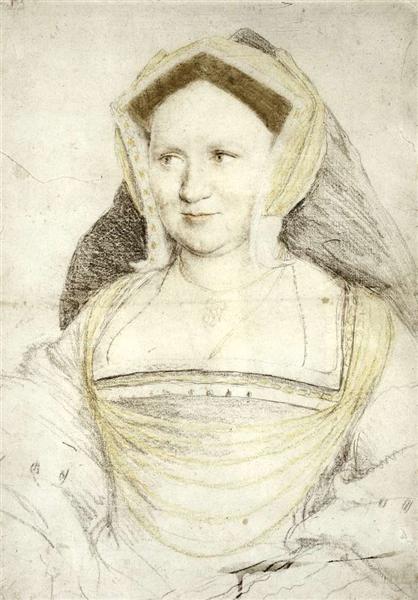Description
La peinture "Portrait de Lady María Guildford", réalisée par Hans Holbein, le jeune homme en 1527, est une œuvre qui résume la maîtrise du portraitiste de la Renaissance et son attention aux détails, ainsi que sa forte sensibilité à la psychologie du sujet . Dans cette œuvre, Holbein démontre sa capacité à fusionner l'art de la représentation fidèle avec l'exploration de l'identité individuelle, une caractéristique distinctive du portrait au XVIe siècle.
Lady María Guildford apparaît dans une pose frontale, avec un regard qui rayonne une sérénité contenue. La composition est soigneusement équilibrée, avec le visage du noble au centre, flanqué des larges plis de sa robe qui, à son tour, conduit le regard du spectateur vers son visage. La robe riche que vous avez vue, ornée de l'or fait brodé sur un fond sombre, met en évidence non seulement son statut social, mais aussi les compétences techniques de Holbein. Les détails du tissu, habilement représentés, créent un sentiment de profondeur et de texture qui ajoute un niveau supplémentaire de réalisme au travail.
L'utilisation de la couleur dans le portrait est caractéristique de Holbein. Le fond sombre des tonalités contraste avec la peau pâle de Lady María, qui présente une subtile luminosité naturelle. La lumière semble tomber délicatement sur son visage, accentuant la douceur de ses traits et de ses jeunes, qui pourraient être interprétés comme un ton d'admiration envers la femme qui dépeint. Les yeux de Lady María, d'une couleur brune et expressive intense, regardent le spectateur avec une confiance qui suggère une connaissance approfondie de son caractère et de sa position.
L'attention aux détails est remarquable dans la coiffure qui orne la tête, un élément qui reflète non seulement la mode de l'époque, mais aussi les idéaux de beauté et de vertu dans la noblesse médiévale. Ce type de coiffure, qui ressemble à un bandeau, met l'accent sur la dignité et le statut de son transporteur. Une telle attention aux vêtements suggère également un lien direct avec le contexte socioéconomique de la Renaissance anglaise, où les vêtements étaient un puissant symbole d'identité personnelle et familiale.
Lorsque vous placez ce portrait dans le cadre plus large du travail de Holbein, il est impératif de reconnaître que son style était caractérisé par une précision remarquable dans le détail et une approche psychologique dans leurs portraits, qui couvrait à la fois l'aristocratie et les membres de la cour. Habituellement, Holbein a utilisé une palette de couleurs riches et saturées, combinant la représentation minutieuse de la figure humaine avec un environnement austère qui améliorait la figure principale. Des œuvres similaires, telles que les portraits d'Enrique VIII, reflètent cette même approche, soulignant l'interrelation entre l'individualité et le contexte social.
Le "Portrait de Lady María Guildford" n'est pas seulement une représentation graphique de son sujet, mais vous invite également à réfléchir sur le rôle des femmes à l'époque de Holbein, à une époque où leur présence dans la sphère publique a commencé à être reconnue. Grâce à son maître coup de pinceau, Holbein capture non seulement l'apparence extérieure de la noblesse, mais aussi un aperçu de l'essence de son être, créant une connexion émotionnelle qui transcende le temps et l'espace.
En conclusion, cette œuvre de Hans Holbein le jeune homme, au-delà d'être un portrait conventionnel, est un témoignage de la virtuosité de l'artiste et des nuances de l'identité féminine au XVIe siècle. La capacité avec laquelle la composition, la lumière et les détails gèrent que "Portrait de Lady María Guildford" est une étape importante de l'histoire de l'art, un miroir qui reflète à la fois le contexte culturel de son temps et l'intemporalité de la condition humaine de la condition humaine.
KUADROS ©, une peinture célèbre sur votre mur.
Peintures à l'huile fabriquées à la main, avec la qualité des artistes professionnels et le sceau distinctif de KUADROS ©.
Service de reproduction des images avec garantie de satisfaction. Si vous n'êtes pas complètement satisfait de la réplique de votre peinture, nous remboursons votre argent à 100%.

